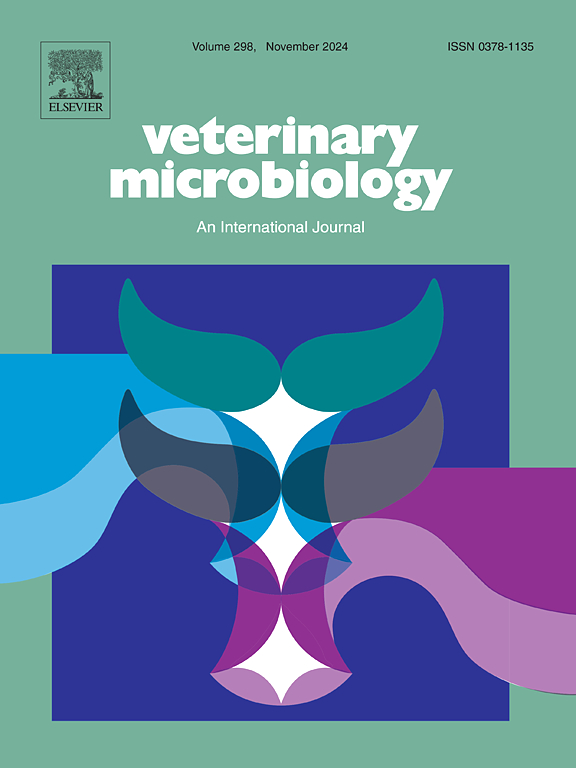2022 至 2023 年中国集约化猪场猪流行性腹泻病毒的流行和脱落情况
IF 2.4
2区 农林科学
Q3 MICROBIOLOGY
引用次数: 0
摘要
猪流行性腹泻已成为全球养猪业的一大威胁。猪流行性腹泻病毒(PEDV)在集约化养猪场的脱落和暴露状况尚不完全清楚。本研究采用实时定量 PCR 技术,对 2022 年至 2023 年期间从中国 20 个省的 256 个集约化猪场采集的 56598 份临床样本进行了 PEDV 评估。在样本和猪场层面,PEDV 的总体流行率分别为 11.78 % 和 28.45 %,在华北地区以及每年的第四季度和第一季度相对较高。乳仔猪群的 PEDV 阳性率和病毒载量均高于生长育成猪和多胎母猪。同时,15.61%的猪栏、9.51%的走廊、9.4%的办公区、9.23%的生产人员和 8.33%的猪车司机样本对 PEDV 呈阳性,这表明集约化猪场可能存在生物安全漏洞。此外,93.41% 的腹股沟淋巴结组织样本含有病毒核酸,揭示了 PEDV 可能在猪群中持续感染。我们的研究首次报告了在集约化养猪场大规模检测到 PEDV 的情况,这构成了猪群中病毒传播的间接证据。这项研究为今后预防和控制 PEDV 感染提供了宝贵的数据。本文章由计算机程序翻译,如有差异,请以英文原文为准。
The prevalence and shedding of porcine epidemic diarrhea virus in intensive swine farms of China from 2022 to 2023
Porcine epidemic diarrhea has emerged as a significant threat to the global swine industry. The shedding and exposure status of porcine epidemic diarrhea virus (PEDV) in intensive farms is not completely understood. In this study, a total of 56,598 clinical samples collected from 256 intensive pig farms in 20 provinces in China from 2022 to 2023, were evaluated for PEDV using quantitative real-time PCR. The overall PEDV prevalence was 11.78 % and 28.45 % at the sample and farm levels, respectively, which are relatively high in Northern China and the fourth and first quarter of the year. The PEDV-positive rates and viral loads in suckling piglet herds were higher than those in growing-finishing pigs and multiparous sows. Meanwhile, 15.61 % of pig pens, 9.51 % of corridors, 9.4 % of office areas, 9.23 % of production personnel, and 8.33 % of pig cart driver samples were positive for PEDV, indicating potential biosafety gaps in intensive pig farms. In addition, 93.41 % of inguinal lymph node tissue samples contained viral nucleic acids, revealing a possible persistent infection of PEDV in pig herds. Our study presents the first report of the large-scale detection of PEDV in intensive pig farms, which constitutes indirect evidence of virus circulation in pig herds. This study provides valuable data for preventing and controlling PEDV infection in the future.
求助全文
通过发布文献求助,成功后即可免费获取论文全文。
去求助
来源期刊

Veterinary microbiology
农林科学-兽医学
CiteScore
5.90
自引率
6.10%
发文量
221
审稿时长
52 days
期刊介绍:
Veterinary Microbiology is concerned with microbial (bacterial, fungal, viral) diseases of domesticated vertebrate animals (livestock, companion animals, fur-bearing animals, game, poultry, fish) that supply food, other useful products or companionship. In addition, Microbial diseases of wild animals living in captivity, or as members of the feral fauna will also be considered if the infections are of interest because of their interrelation with humans (zoonoses) and/or domestic animals. Studies of antimicrobial resistance are also included, provided that the results represent a substantial advance in knowledge. Authors are strongly encouraged to read - prior to submission - the Editorials (''Scope or cope'' and ''Scope or cope II'') published previously in the journal. The Editors reserve the right to suggest submission to another journal for those papers which they feel would be more appropriate for consideration by that journal.
Original research papers of high quality and novelty on aspects of control, host response, molecular biology, pathogenesis, prevention, and treatment of microbial diseases of animals are published. Papers dealing primarily with immunology, epidemiology, molecular biology and antiviral or microbial agents will only be considered if they demonstrate a clear impact on a disease. Papers focusing solely on diagnostic techniques (such as another PCR protocol or ELISA) will not be published - focus should be on a microorganism and not on a particular technique. Papers only reporting microbial sequences, transcriptomics data, or proteomics data will not be considered unless the results represent a substantial advance in knowledge.
Drug trial papers will be considered if they have general application or significance. Papers on the identification of microorganisms will also be considered, but detailed taxonomic studies do not fall within the scope of the journal. Case reports will not be published, unless they have general application or contain novel aspects. Papers of geographically limited interest, which repeat what had been established elsewhere will not be considered. The readership of the journal is global.
 求助内容:
求助内容: 应助结果提醒方式:
应助结果提醒方式:


